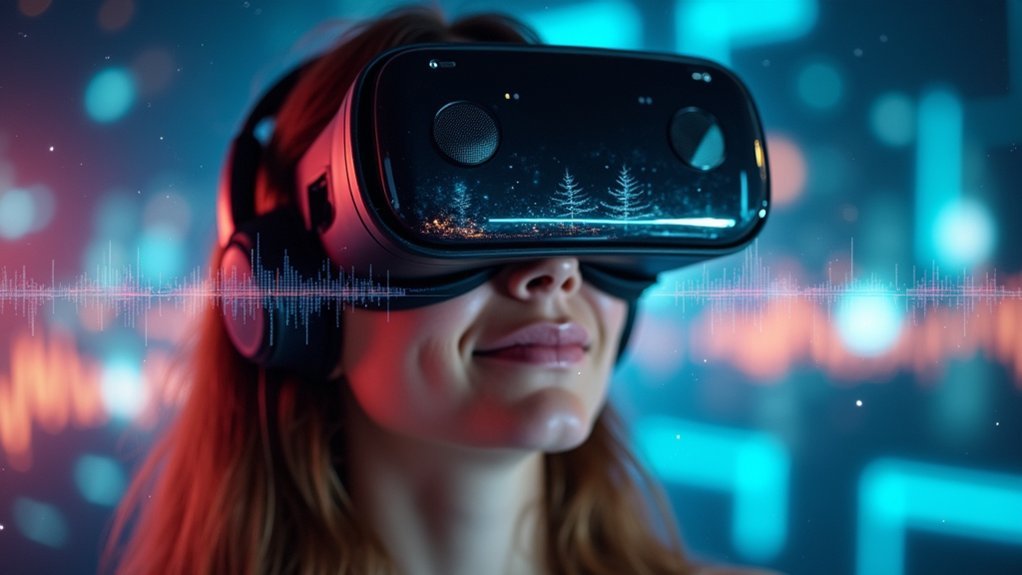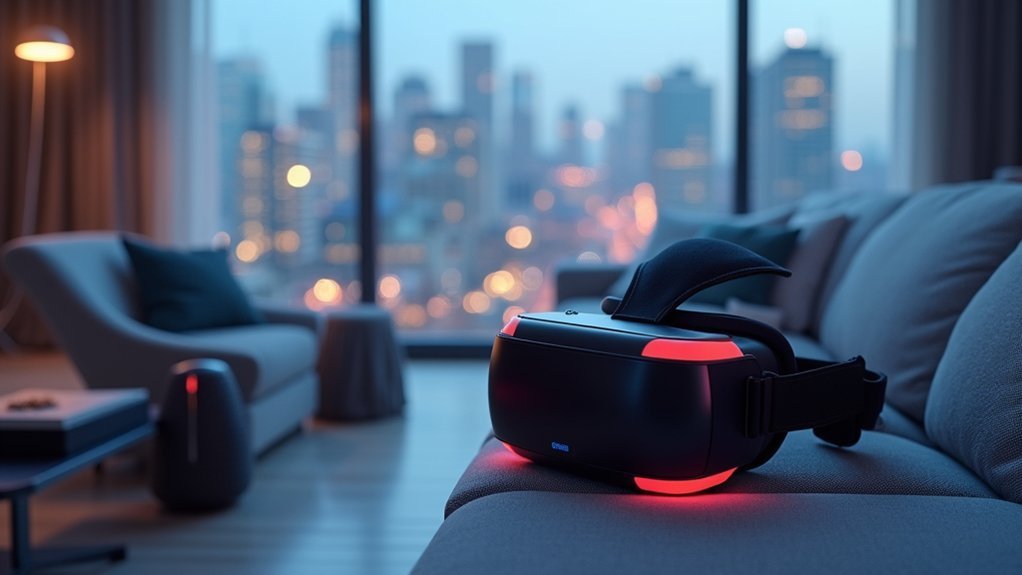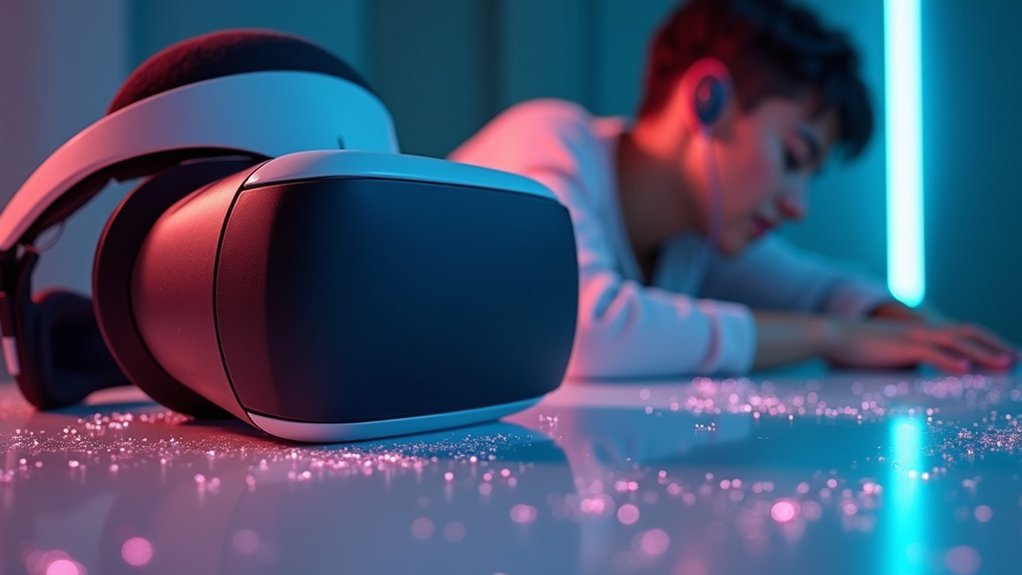Your spatial audio lags in VR because of Motion-to-Sound Latency – the delay between your head movement and corresponding audio changes. This happens when your headset’s processing power can’t keep up with real-time spatial calculations, Bluetooth headphones add 100-500 milliseconds of transmission delay, and external audio software creates routing bottlenecks. Poor head tracking hardware, CPU strain, and complex 3D environments compound these issues. Understanding each component’s impact will help you optimize your immersive experience.
Understanding Motion-to-Sound Latency in VR Environments

When you move your head in VR, there’s a measurable delay between that physical movement and when the corresponding audio changes reach your ears—this gap is called Motion-to-Sound Latency (M2S Latency).
This latency represents the total time required for your movements to be detected and translated into audio changes, directly impacting your immersion in virtual environments.
Motion-to-sound latency consists of multiple components working in sequence. Your movement first triggers motion-to-sensor latency, followed by sensor-to-processor latency as data transfers to the system.
Then rendering latency occurs while the audio processes, and finally communication latency happens during signal transmission to your headphones.
Each component adds milliseconds to the total delay, creating the lag you experience between head movement and corresponding spatial audio adjustments.
Hardware Limitations That Create Audio Delays
Understanding the timing components behind audio lag reveals only part of the story—your VR headset’s physical hardware creates the other half of this latency puzzle.
Your headset’s onboard audio chip determines how quickly spatial audio renders. When processing power falls short, delays accumulate rapidly.
Bluetooth connections worsen this problem, introducing 100-500 milliseconds of transmission delay between your headset and audio devices.
The audio drivers and codecs you’re using matter considerably. Lower-quality components directly translate to higher latency during spatial processing.
Your motion sensors also play an essential role—inferior tracking hardware can’t detect head movements quickly enough for real-time audio adjustments.
These hardware limitations become especially apparent during rapid movements, when limited memory and bandwidth restrict simultaneous audio-visual processing, creating noticeable delays.
Bluetooth Connectivity and Wireless Audio Processing Issues

While your VR headset’s internal components create one layer of audio delay, Bluetooth connectivity introduces an entirely separate—and often more severe—bottleneck.
When you use Bluetooth headphones, you’re adding roughly half a second of transmission lag that devastates spatial audio responsiveness. This delay compounds existing latencies from motion sensors, processors, and rendering systems.
Bluetooth chip limitations mean digital processing struggles with the rapid positional updates VR demands.
Network congestion further amplifies these delays, creating a cascade of audio lag that breaks immersion. Your head movements won’t sync with corresponding sound changes, making spatial audio feel disconnected and artificial.
For peak VR performance, you should avoid Bluetooth headphones entirely.
Wired connections eliminate transmission delays, while manufacturers continue developing wireless technologies specifically designed to minimize motion-to-sound latency in virtual environments.
External Audio Software Interference Problems
Beyond hardware limitations, external audio software creates its own web of interference that can sabotage your VR’s spatial audio performance. Applications like Voicemeter might offer advanced features, but they’re notorious for introducing significant latency into your audio pipeline.
When you’re using external audio software, you’ll encounter three critical interference problems:
- Pipeline Delays: Audio routing through external applications adds milliseconds to half-second delays, destroying real-time spatial accuracy.
- Configuration Complications: Incorrect settings in your external audio software amplify latency issues and disrupt immersive experiences.
- Chain Complexity: Additional processing layers create communication bottlenecks that compromise audio responsiveness.
You’ll notice these delays most during rapid head movements or fast-paced VR scenarios where spatial audio should seamlessly follow your perspective changes.
Head Tracking Accuracy and Response Time Factors
When your VR headset can’t accurately track head movements, spatial audio immediately falls out of sync with your visual experience.
Head tracking accuracy depends on sensors detecting your movements and communicating with the processing unit. If sensor response time is slow or communication delays occur between components, you’ll notice audio lag.
M2S Latency comprises motion-to-sensor, sensor-to-processor, rendering, and communication latencies. Each component adds to the perceived disconnect between visual and audio cues. High-quality VR systems target M2S Latency below 20 milliseconds for immersive experiences.
Processing delays from inefficient algorithms worsen this problem. External noise interference, software inefficiencies, and hardware limitations like Bluetooth communication delays can further exacerbate spatial audio lag, making your virtual environment feel disconnected and less convincing.
Audio Rendering Pipeline Bottlenecks
After your head movement registers with the sensors, the audio rendering pipeline creates a cascade of processing delays that compound spatial audio lag.
Each stage in this pipeline adds latency that directly impacts your VR experience’s M2S Latency.
The pipeline’s bottlenecks occur in three critical areas:
- Motion-to-sensor delays – Your tracking technology introduces 10-20 milliseconds before movement registers
- Audio processing latency – Complex spatial calculations add 20-50 milliseconds during rendering
- Communication delays – Wireless transmission, especially Bluetooth, contributes 30-100 milliseconds
These cumulative delays disrupt synchronization between what you see and hear.
When you turn your head, the visual feedback responds faster than spatial audio positioning, breaking immersion.
Even minor delays become noticeable because your brain expects instant auditory adjustments to match visual changes.
System Performance Impact on Spatial Audio Processing
Your VR system’s performance directly determines how smoothly spatial audio responds to your movements.
When your CPU struggles with processing overhead or memory allocation creates bottlenecks, you’ll notice audio lag as the system can’t keep up with real-time rendering demands.
These performance constraints force your system to prioritize certain processes over others, often leaving spatial audio processing waiting in line.
CPU Processing Overhead
Although VR systems excel at creating immersive visual experiences, they often struggle with spatial audio lag due to CPU processing overhead that divides computational resources between multiple demanding tasks.
When your system faces CPU processing overhead, you’ll notice delays in the audio pipeline that directly impact sound delivery speed. Your CPU must juggle graphics rendering while processing complex spatial audio algorithms that require real-time calculations for sound positioning and environmental simulation.
Here’s what happens when CPU resources become strained:
- Motion-to-sound latency increases – Your system can’t maintain the low M2S timing essential for immersive VR.
- Audio processing delays accumulate – Sound cues reach you slower than intended.
- Real-time computations suffer – Environmental audio simulations lag behind your movements.
You can minimize these issues by optimizing CPU performance through efficient coding practices and better resource management.
Memory Allocation Bottlenecks
Beyond CPU constraints, memory allocation bottlenecks create another considerable barrier to smooth spatial audio performance in VR environments. When your system’s RAM can’t handle simultaneous audio processing and rendering demands, you’ll experience delays in spatial audio responsiveness. High-quality spatial audio requires substantial memory bandwidth, and multiple active audio channels can overwhelm your system’s resources, causing noticeable lag.
Inefficient memory management compounds these issues. Memory fragmentation and excessive background processes slow down audio data retrieval and processing, making your VR experience less immersive.
Advanced techniques like real-time environmental modeling increase memory usage considerably, potentially causing performance drops on unoptimized systems.
You can reduce these memory allocation bottlenecks by optimizing allocation strategies and upgrading to faster memory types like DDR4 or DDR5, which greatly improve spatial audio latency.
Real-time Rendering Demands
When your VR system processes complex 3D environments, the simultaneous demands of graphics and spatial audio rendering create significant performance bottlenecks that directly impact audio responsiveness.
Your Motion-to-Sound Latency increases when the audio processing unit can’t keep pace with rapid head movements, creating a disjointed experience.
Three critical factors affect your spatial audio technology performance:
- Frame rate optimization – Higher frame rates demand more processing power, leaving fewer resources for audio calculations.
- Graphical fidelity settings – Complex visual effects compete directly with audio processing for computational bandwidth.
- Audio environment complexity – Dense soundscapes with multiple sources require exponentially more processing power.
You’ll notice lag when communication bottlenecks occur between sensors, processors, and output devices, disrupting the real-time audio pipeline essential for immersion.
Network and Communication Latency Effects
When you’re experiencing spatial audio lag in VR, network and communication delays often serve as the primary culprits behind the frustrating disconnect between your movements and audio responses.
Bluetooth connections can add 100-200 milliseconds of delay to your audio transmission, while network congestion creates additional packet loss and increased lag that disrupts real-time processing.
You’ll also encounter digital processing overhead that compounds these delays, creating the motion-to-sound latency that breaks immersion and can even trigger motion sickness.
Bluetooth Transmission Delays
Although VR systems increasingly rely on wireless audio solutions for untethered experiences, Bluetooth transmission introduces considerable delays that can cripple spatial audio performance.
You’ll encounter latency ranging from 100-300 milliseconds, which destroys the precise timing needed for immersive spatial audio. This delay stems from digital compression and decompression processing required for wireless transmission.
Bluetooth transmission delays worsen your VR experience through:
- Codec limitations – Different audio profiles (SBC, AAC, aptX) create varying latency levels, with some prioritizing quality over speed.
- Network interference – Other wireless devices competing for bandwidth can amplify delays considerably.
- Motion-to-Sound disruption – High transmission delays break the critical synchronization between your head movements and corresponding audio changes.
These delays create a disjointed experience where spatial audio lags behind your movements.
Network Congestion Impact
Beyond individual device limitations, network congestion creates another layer of audio delays that can devastate your VR spatial audio experience.
When multiple users share the same network during peak hours, data packets struggle to reach their destination quickly, causing noticeable audio lag. You’ll experience audio-visual desynchronization where sounds don’t match what you’re seeing, breaking immersion completely.
Network congestion particularly affects multiplayer VR environments where voice communication becomes choppy and delayed.
You’ll find it nearly impossible to coordinate with teammates when conversations lag behind actions. The spatial audio positioning also suffers, with directional cues arriving too late to provide useful information.
To combat these issues, switch to wired connections and prioritize VR traffic in your router settings for peak performance.
Digital Processing Overhead
Digital processing overhead compounds your VR audio lag problems through multiple computational bottlenecks that stack delays throughout the entire audio pipeline.
When you’re immersed in virtual environments, your headset must process massive amounts of spatial audio data in real-time, creating significant delays that directly impact your sound experience.
The cumulative motion-to-sound latency affects your immersion through:
- Encoding and decoding delays – Audio signals require time-intensive compression and decompression processes.
- Wireless transmission lag – Bluetooth and other wireless protocols add communication delays between devices.
- Rendering bottlenecks – Complex spatial calculations slow down real-time audio positioning updates.
High-quality spatial audio systems combat digital processing overhead by implementing optimized algorithms and faster communication protocols, ensuring your movements trigger immediate audio responses rather than noticeable delays.
Frequently Asked Questions
How Do I Reduce Lag in VR?
You’ll reduce VR lag by updating audio drivers, using wired headphones instead of Bluetooth, optimizing app audio settings, testing different output devices, and regularly restarting your headset to refresh connections.
Is Spatial Audio Good for Gaming?
You’ll gain significant advantages with spatial audio in gaming. It improves your situational awareness, reaction times, and performance by letting you accurately locate threats, footsteps, and environmental sounds for competitive edge.
Does Spatial Audio Ruin Sound Quality?
Spatial audio doesn’t ruin sound quality when properly implemented. You’ll experience enhanced immersion and directional accuracy. However, if you encounter high latency or poor processing techniques, you might notice audio artifacts that compromise your overall listening experience.
How to Fix Sound on VR?
Update your VR headset’s audio drivers and firmware first. Check audio routing settings in external programs like Voicemeter. Try wired connections instead of Bluetooth headphones. Use audio test apps to calibrate, then restart everything.
In Summary
You’re experiencing spatial audio lag because your VR system’s struggling with multiple bottlenecks simultaneously. Your hardware can’t process audio fast enough, Bluetooth connections introduce delays, and external software interferes with rendering pipelines. When you move your head, there’s a delay between motion detection and audio adjustment. You’ll need to optimize your system performance, use wired audio when possible, and close unnecessary background applications to minimize these latency issues.





Leave a Reply